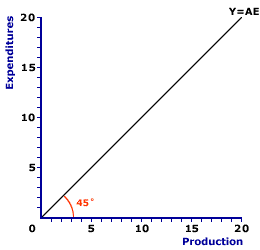
|
|
ABSTRACTION: Simplifying the complexities of the real world by ignoring (hopefully) unimportant details while doing economic analysis. Abstraction is often criticized because it's, well, it's JUST NOT REALISTIC. However, when done correctly (ignoring things that JUST DON'T MATTER), then the pursuit of knowledge is greatly enhanced by abstraction. For example, when travelling cross country along a high-speed interstate highway, a paper road map is a handy tool. It shows towns and cities along the way, the major intersections, rest stop locations, and other important points of interest. However, it ignores unimportant details. It doesn't realistically show the location of every tree, bush, or blade of grass. Why bother? This information won't enhance your road trip.
Visit the GLOSS*arama
|
|


|

|
                           45-DEGREE LINE: A line that shows equality between the variable measured on the vertical axis of a diagram and the variable measured on the horizontal axis. A 45-degree line is used both as a guideline that provides insight into the measured variables and as a critical part of the analysis. This line is perhaps most important in Keynesian economics. It is used in a diagram measuring consumption and income as a means of deriving saving---the difference between income and consumption. It is also used in the Keynesian model (or Keynesian cross) diagram measuring aggregate expenditures and aggregate production as a means of identifying equilibrium--the equality between aggregate expenditures and aggregate production. | 45-Degree Line |  |
The 45-degree line assists in the Keynesian economics evaluation and analysis of the macroeconomy. In general, a 45-degree line is so named because it forms a 45-degree angle with both the vertical or horizontal axes of a typical right-angle diagram. This is achieve because each point on the 45-degree line equates the variable measured on the vertical axis with the variable measured on the horizontal axis. Because the two variables are measured in the same units, the 45-degree line has a slope of one and it bisects the 90-degree angle formed by the vertical and horizontal axes.A typical 45-degree line is presented in the exhibit to the right. In this particular exhibit, expenditures (aggregate expenditures) are measured on the vertical axis and production (aggregate production) is measured on the horizontal axis. The 45-degree line then depicts each point in this diagram in which aggregate production (Y) is equal to aggregate expenditures (AE). For this reason, the 45-degree line is also labeled Y=AE. The two most common uses of the 45-degree line are the Keynesian model and the consumption line. - Keynesian Model: The most important use of the 45-degree is the Keynesian model, which identifies equilibrium equality between aggregate expenditures and aggregate production. In particular, the intersection between the 45-degree line and the aggregate expenditures line indicates the equilibrium level of aggregate production.
- Consumption Line: The 45-degree line is also used as a guide for working with the consumption line. Because the 45-degree line has a slope of one, it serves to highlight that the slope of the consumption line is less that one. Moreover, because the 45-degree in this diagram shows the equality between consumption and income, it can be used to easily identify saving as the vertical difference between the consumption line an the 45-degree line.

Recommended Citation:45-DEGREE LINE, AmosWEB Encyclonomic WEB*pedia, http://www.AmosWEB.com, AmosWEB LLC, 2000-2025. [Accessed: July 5, 2025].
Check Out These Related Terms... | | | | | | | | | |
Or For A Little Background... | | | | |
And For Further Study... | | | | | | | | | | |
Search Again?
Back to the WEB*pedia
|



|

|
|
Helping spur the U.S. industrial revolution, Thomas Edison patented nearly 1300 inventions, 300 of which came out of his Menlo Park "invention factory" during a four-year period.
|

|
|
"Plans are only good intentions unless they immediately degenerate into hard work." -- Peter Drucker, management consultant
|

|
CRA
Community Reinvestment Act, Contemporaneous Reserve Accounting
|

|
|
Tell us what you think about AmosWEB. Like what you see? Have suggestions for improvements? Let us know. Click the User Feedback link.
User Feedback
|


|


